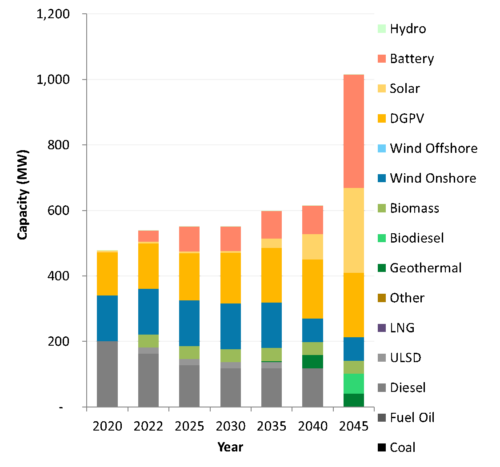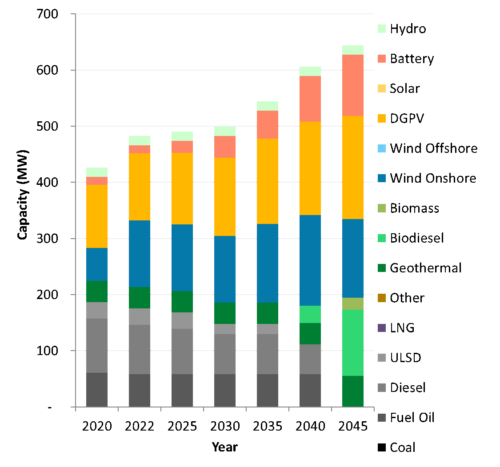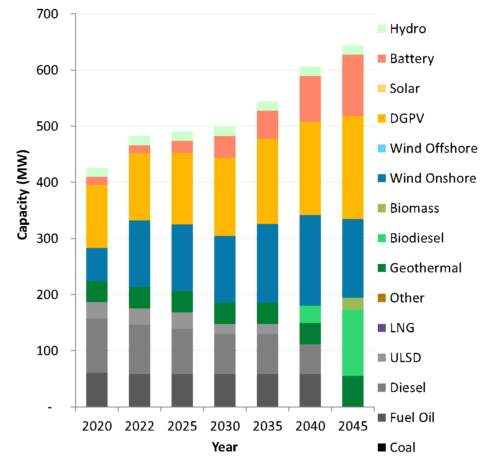 In 2015, Hawai‘i passed unprecedented legislation, Act 97, which requires its investor-owned utility, Hawaiian Electric Company (HECO), to meet a 100 percent renewable portfolio standard (RPS) by the end of 2045. Strengthening the state’s economy depends on moving away from imported fossil fuels for both electricity and transportation and increasing reliance on its abundant renewable energy resources.
In 2015, Hawai‘i passed unprecedented legislation, Act 97, which requires its investor-owned utility, Hawaiian Electric Company (HECO), to meet a 100 percent renewable portfolio standard (RPS) by the end of 2045. Strengthening the state’s economy depends on moving away from imported fossil fuels for both electricity and transportation and increasing reliance on its abundant renewable energy resources.
To map out the transition to a 100 percent renewable grid, HECO needs to work with a diverse array of stakeholders, including state and local governments, private landowners, the tourism industry, renewable energy developers, consumer advocates, and environmentalists. With so many perspectives, arriving at a common vision for how to meet the RPS goal will not be easy. In particular, HECO needs to limit cost increases, as Hawaiians already face the highest electricity rates in the nation.
To develop an affordable, technically feasible plan that could win broad support, the company needed guidance. To provide that analysis, HECO hired E3 based on our experience in modeling electricity systems; our groundbreaking work in long-term, high-RPS planning in California and New York; and our unbiased, fact-based approach to working with utilities, regulators, environmentalists, and other stakeholders.
Hawai‘i has been E3’s most challenging RPS case. The loosely related islands vary in size, population, and wealth, adding to the unique problems presented by location and geography. Nevertheless, using our Renewable Integration Solutions Model (RESOLVE), we demonstrated multiple pathways that Hawai‘i could take to achieve 100 percent RPS by 2045. A summary of our findings was published in the December 2016 HECO PSIP Update Report.
Isolated grids pose unique planning challenges
HECO’s system consists of five island grids that are not connected by transmission cables, and each must rely on its own limited resources to provide reliable service. Although Hawai‘i boasts high-quality wind and solar resources, their intermittency can produce reliability issues, which are magnified by a lack of diverse resources and loads and by the relatively small size of each island system.
Many of the engineering rules that guide larger mainland utilities do not apply in this case. Small islands must maintain substantial levels of operating reserves to handle uncertainty in net loads and unanticipated contingencies. The challenging operating environment translates to a need for higher planning reserve margins as well—the relatively low-demand islands of Maui and Hawai‘i have margins that are more than twice those of large mainland utilities.
Transparent modeling informs stakeholder process
To avoid the confusion that would arise if stakeholders used competing planning models, E3 created scenarios under a range of assumptions and specifications given to us by the utility and stakeholders. We used a transparent standard input table to gather data for RESOLVE in order to develop least cost expansion plans through 2045 for Oahu, Maui, and Hawai‘i Island.
The RESOLVE analysis allowed both the utility and stakeholders to identify a series of realistic choices, including how much grid-scale wind or solar to develop, how much rooftop PV can be interconnected, when to shut down thermal plants, and when to build storage.
The scenarios we examined included one with new undersea cables connecting the Maui and Hawai‘i Island grids with Oahu’s system and another with a new combined cycle natural gas plant and LNG infrastructure. HECO is considering investing in LNG facilities as an early step toward developing the 100 percent RPS plan and cutting overall energy costs.
To understand the potential bill impacts of meeting the 100 percent RPS, the state’s consumer advocate also asked us to develop a case for each island comparing the costs of our RPS-compliant cases with the least cost plans without an RPS. We found that the cost of the non-RPS cases are, respectively, only 1, 2, and 13 percent lower than the costs of the RPS-compliant plans for Oahu, Maui, and Hawai‘i when there is no investment in LNG.
Examples of the resource investment plans E3 developed for each of the three islands are shown in the charts below; each figure demonstrates how an island’s resource mix would change over time as renewables replace coal- and petroleum-fueled generation. Our assumption set excludes new natural gas infrastructure and includes a forecast of distributed generation photovoltaics (DGPV) based on HECO’s projection of rates and markets.
HECO proposes revised five-year resource plans
E3 provided HECO with several least cost plans for achieving a 100 percent RPS. HECO drew upon this work to develop the PSIP update, which it submitted to the Hawai‘i Public Utilities Commission in December 2016. The five-year plan lays out initial steps that HECO can take toward achieving the 100 percent goal, while allowing flexibility to take advantage of future advances in technology. The state must now decide which pathway best accommodates the needs of all islands.
Base case scenario for RPS compliance: No-LNG and Market DGPV Adoption
Utilized installed capacity (MW)
ALL E3 PROJECTS





